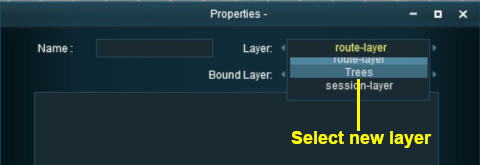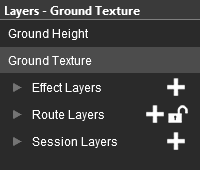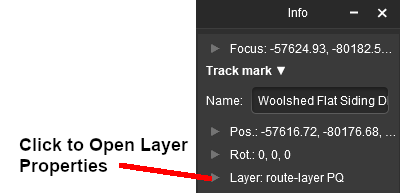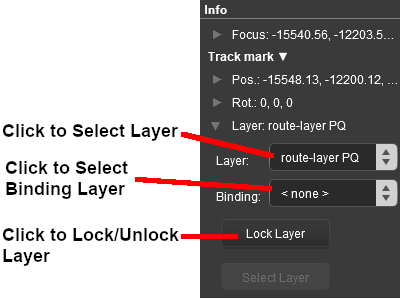How to Use Layers
m (→The "session-layer") |
m |
||
| Line 5: | Line 5: | ||
<td width=46> </td> | <td width=46> </td> | ||
<td width=75> </td> | <td width=75> </td> | ||
| − | <td width=75>[[ | + | <td width=75>[[image:NextDown.png|link=#stepWhat|alt=Next Down|Next Down]]</td> |
| − | <td width=75>[[ | + | <td width=75>[[image:BackToBottom.png|link=#bottom|alt=Bottom|Bottom]]</td> |
</tr> | </tr> | ||
</table> <!-- END Nav Buttons Table --> | </table> <!-- END Nav Buttons Table --> | ||
| Line 87: | Line 87: | ||
<td width=50> </td> <!-- skip Down --> | <td width=50> </td> <!-- skip Down --> | ||
<td width=50> </td> <!-- skip Up --> | <td width=50> </td> <!-- skip Up --> | ||
| − | <td width=46>[[ | + | <td width=46>[[image:BackToTop.png|link=#top|alt=Top|Top]]</td> |
<td width=75> </td> | <td width=75> </td> | ||
| − | <td width=75>[[ | + | <td width=75>[[image:NextDown.png|link=#stepToolsS10|alt=Next Down|Next Down]]</td> |
| − | <td width=75>[[ | + | <td width=75>[[image:BackToBottom.png|link=#bottom|alt=Bottom|Bottom]]</td> |
</tr> | </tr> | ||
</table> <!-- END Nav Buttons Table --> | </table> <!-- END Nav Buttons Table --> | ||
| Line 133: | Line 133: | ||
<table width=900> | <table width=900> | ||
<tr valign="top"> | <tr valign="top"> | ||
| − | <td width=10>[[ | + | <td width=10>[[image:DotPoint.JPG|10px|link=]]</td> |
<td>'''Route Layers''' will contain the objects that will appear in '''ALL''' the sessions created using the current route</td> | <td>'''Route Layers''' will contain the objects that will appear in '''ALL''' the sessions created using the current route</td> | ||
</tr> | </tr> | ||
<tr valign="top"> | <tr valign="top"> | ||
| − | <td>[[ | + | <td>[[image:DotPoint.JPG|10px|link=]]</td> |
<td>'''Session Layers''' will contain the objects that will only appear in the current session</td> | <td>'''Session Layers''' will contain the objects that will only appear in the current session</td> | ||
</tr> | </tr> | ||
<tr valign="top"> | <tr valign="top"> | ||
| − | <td>[[ | + | <td>[[image:DotPoint.JPG|10px|link=]]</td> |
<td>'''Effect Layers''' ('''Trainz Plus''' and '''TRS22''') will contain the '''TurfFX''', '''Clutter''' and '''Water''' effects created using the current route</td> | <td>'''Effect Layers''' ('''Trainz Plus''' and '''TRS22''') will contain the '''TurfFX''', '''Clutter''' and '''Water''' effects created using the current route</td> | ||
</tr> | </tr> | ||
| Line 152: | Line 152: | ||
<td width=50>[[image:SkipDown.png|link=#skipLoadingS10|Skip Down]]</td> <!-- skip Down --> | <td width=50>[[image:SkipDown.png|link=#skipLoadingS10|Skip Down]]</td> <!-- skip Down --> | ||
<td width=50> </td> <!-- skip Up --> | <td width=50> </td> <!-- skip Up --> | ||
| − | <td width=46>[[ | + | <td width=46>[[image:BackToTop.png|link=#top|alt=Top|Top]]</td> |
| − | <td width=75>[[ | + | <td width=75>[[image:NextUp.png|link=#stepWhat|alt=Next Up|Next Up]]</td> |
| − | <td width=75>[[ | + | <td width=75>[[image:NextDown.png|link=#stepToolsS20|alt=Next Down|Next Down]]</td> |
| − | <td width=75>[[ | + | <td width=75>[[image:BackToBottom.png|link=#bottom|alt=Bottom|Bottom]]</td> |
</tr> | </tr> | ||
</table> <!-- END Nav Buttons Table --> | </table> <!-- END Nav Buttons Table --> | ||
| Line 163: | Line 163: | ||
<table width=1000> | <table width=1000> | ||
<tr valign="top"> | <tr valign="top"> | ||
| − | <td>[[ | + | <td>[[image:SurveyorToolMenuLayers.JPG|150px]]</td> |
| − | <td><br><br><br><br><br><br><br><br><br><br><br><br><br>[[ | + | <td><br><br><br><br><br><br><br><br><br><br><br><br><br>[[image:RightArrowRed.JPG|link=]]</td> |
<td><span style="font-weight: 700; font-size: 15px; background-color: lightcyan;">Left Click</span> the '''Layers Tool''' (or press <span style="font-weight: 700; font-size: 15px; color: white; background-color: black;"> F6 </span>) to open up its properties.<br> | <td><span style="font-weight: 700; font-size: 15px; background-color: lightcyan;">Left Click</span> the '''Layers Tool''' (or press <span style="font-weight: 700; font-size: 15px; color: white; background-color: black;"> F6 </span>) to open up its properties.<br> | ||
| − | [[ | + | [[image:LayersTools.JPG|480px]]</td> |
<td> | <td> | ||
<br> | <br> | ||
| Line 174: | Line 174: | ||
<table bgcolor=#ffffb0 cellpadding=2 width=396> | <table bgcolor=#ffffb0 cellpadding=2 width=396> | ||
<tr valign="top"> | <tr valign="top"> | ||
| − | <td>[[ | + | <td>[[image:NotePad.PNG|link=]]</td> |
<td><span style="font-size: 17px;">'''Notes:'''</span><br> | <td><span style="font-size: 17px;">'''Notes:'''</span><br> | ||
---- | ---- | ||
| Line 295: | Line 295: | ||
<table width=1000> <!-- BEGIN top level --> | <table width=1000> <!-- BEGIN top level --> | ||
<tr valign="top"> | <tr valign="top"> | ||
| − | <td>[[ | + | <td>[[image:LayersToolsRoute.JPG|link=]]</td> |
| − | <td>[[ | + | <td>[[image:LayersToolsSession.JPG|link=]]</td> |
<td>The first image on the left gives an example of the layers that can appear if a '''Route only''' is loaded into Surveyor. These are the layers that are saved with the Route. '''Note that a default "session-layer" is present'''. | <td>The first image on the left gives an example of the layers that can appear if a '''Route only''' is loaded into Surveyor. These are the layers that are saved with the Route. '''Note that a default "session-layer" is present'''. | ||
<table bgcolor=#000000 cellpadding=2> | <table bgcolor=#000000 cellpadding=2> | ||
| Line 337: | Line 337: | ||
<table bgcolor=#ffffe0> <!-- BEGIN 2nd level Tip --> | <table bgcolor=#ffffe0> <!-- BEGIN 2nd level Tip --> | ||
<tr valign="top"> | <tr valign="top"> | ||
| − | <td>[[ | + | <td>[[image:PencilTips.PNG|link=]]</td> |
<td>If you load a '''Session''' and do not want to edit any of the '''Route layers''' then <span style="font-weight: 700; font-size: 15px; background-color: lightcyan;">Left Click</span> the '''Lock Route Layers''' icon on the '''Layers Tool''' | <td>If you load a '''Session''' and do not want to edit any of the '''Route layers''' then <span style="font-weight: 700; font-size: 15px; background-color: lightcyan;">Left Click</span> the '''Lock Route Layers''' icon on the '''Layers Tool''' | ||
<table> <!-- BEGIN 3rd level --> | <table> <!-- BEGIN 3rd level --> | ||
<tr> | <tr> | ||
| − | <td>[[ | + | <td>[[image:LayersToolButtonsLOCKALL.JPG|link=]]</td> |
<td><span style="font-weight: 700; font-size: 15px; background-color: lightcyan;">Left Click</span> the '''Lock Button''' | <td><span style="font-weight: 700; font-size: 15px; background-color: lightcyan;">Left Click</span> the '''Lock Button''' | ||
</td> | </td> | ||
| Line 362: | Line 362: | ||
<table bgcolor=#fcbcbc cellpadding=2> | <table bgcolor=#fcbcbc cellpadding=2> | ||
<tr valign="top"> | <tr valign="top"> | ||
| − | <td>[[ | + | <td>[[image:Stop.PNG|link=]]</td> |
<td><span style="font-size: 17px; font-weight: 700;">If you load a <span style="text-decoration: underline;">ROUTE</span> but not the SESSION then only <span style="text-decoration: underline;">edit the Route Layers</span></span></td> | <td><span style="font-size: 17px; font-weight: 700;">If you load a <span style="text-decoration: underline;">ROUTE</span> but not the SESSION then only <span style="text-decoration: underline;">edit the Route Layers</span></span></td> | ||
</tr> | </tr> | ||
<tr valign="top"> | <tr valign="top"> | ||
| − | <td>[[ | + | <td>[[image:Stop.PNG|link=]]</td> |
<td><span style="font-size: 17px;">'''If you edit a <span style="text-decoration: underline;">SESSION</span> or its layers then always <span style="text-decoration: underline;">save the Session</span>'''</span></td> | <td><span style="font-size: 17px;">'''If you edit a <span style="text-decoration: underline;">SESSION</span> or its layers then always <span style="text-decoration: underline;">save the Session</span>'''</span></td> | ||
</tr> | </tr> | ||
<tr valign="top"> | <tr valign="top"> | ||
| − | <td>[[ | + | <td>[[image:Stop.PNG|link=]]</td> |
<td><span style="font-size: 17px;">'''When you save a new <span style="text-decoration: underline;">SESSION</span> always give it a name, do <span style="text-decoration: underline;">NOT</span> leave it as "Default"</span> | <td><span style="font-size: 17px;">'''When you save a new <span style="text-decoration: underline;">SESSION</span> always give it a name, do <span style="text-decoration: underline;">NOT</span> leave it as "Default"</span> | ||
</td> | </td> | ||
| Line 395: | Line 395: | ||
<table> | <table> | ||
<tr valign="top"> | <tr valign="top"> | ||
| − | <td>[[ | + | <td>[[image:LayersNewRoute.JPG|link=]]</td> |
<td> | <td> | ||
<table bgcolor=#000000 width=604> | <table bgcolor=#000000 width=604> | ||
| Line 402: | Line 402: | ||
<table bgcolor=#ffffb0 width=600> | <table bgcolor=#ffffb0 width=600> | ||
<tr valign="top"> | <tr valign="top"> | ||
| − | <td>[[ | + | <td>[[image:NotePad.PNG|link=]]</td> |
<td><span style="font-size: 17px;">'''Notes:'''</span><br> | <td><span style="font-size: 17px;">'''Notes:'''</span><br> | ||
---- | ---- | ||
| Line 421: | Line 421: | ||
<table width=600 bgcolor=#ffffe0> | <table width=600 bgcolor=#ffffe0> | ||
<tr valign="top"> | <tr valign="top"> | ||
| − | <td>[[ | + | <td>[[image:PencilTips.PNG|link=]]</td> |
<td>'''A layer can be renamed at anytime by a''' <span style="font-weight: 700; font-size: 15px; background-color: lightcyan;">Double Left Click</span> '''on its name and entering a new name''' | <td>'''A layer can be renamed at anytime by a''' <span style="font-weight: 700; font-size: 15px; background-color: lightcyan;">Double Left Click</span> '''on its name and entering a new name''' | ||
</td> | </td> | ||
| Line 479: | Line 479: | ||
<table bgcolor=#ffffb0 width=496> | <table bgcolor=#ffffb0 width=496> | ||
<tr valign="top"> | <tr valign="top"> | ||
| − | <td>[[ | + | <td>[[image:NotePad.PNG|link=]]</td> |
<td colspan=2><span style="font-size: 17px;">'''Notes:'''</span><br> | <td colspan=2><span style="font-size: 17px;">'''Notes:'''</span><br> | ||
---- | ---- | ||
| Line 505: | Line 505: | ||
<table bgcolor=#fcbcbc width=484> | <table bgcolor=#fcbcbc width=484> | ||
<tr valign="top"> | <tr valign="top"> | ||
| − | <td>[[ | + | <td>[[image:Stop.PNG|link=]]</td> |
<td>'''Trainz''' does not identify which is the '''Active Layer''' in '''Surveyor''' and this often leads to problems such as objects being added to the wrong layer.<br> | <td>'''Trainz''' does not identify which is the '''Active Layer''' in '''Surveyor''' and this often leads to problems such as objects being added to the wrong layer.<br> | ||
| − | See [[ | + | See [[image:PageLink.PNG|link=]] '''[[#Adding Objects To Layers|Adding Objects To Layers]]''' below for more information. |
</td> | </td> | ||
</tr> | </tr> | ||
| Line 535: | Line 535: | ||
<table width=1000> | <table width=1000> | ||
<tr> | <tr> | ||
| − | <td>[[ | + | <td>[[image:LayersToolButtonsADD.JPG|link=]]</td> |
<td><span style="font-weight: 700; font-size: 15px; background-color: lightcyan;">Left Click</span> the '''Add Button'''</td> | <td><span style="font-weight: 700; font-size: 15px; background-color: lightcyan;">Left Click</span> the '''Add Button'''</td> | ||
</tr> | </tr> | ||
| Line 544: | Line 544: | ||
<table width=1000> | <table width=1000> | ||
<tr valign="top"> | <tr valign="top"> | ||
| − | <td>[[ | + | <td>[[image:LayersAddLayer.JPG|link=]]</td> |
<td> | <td> | ||
<table bgcolor=#000000 cellpadding=2> | <table bgcolor=#000000 cellpadding=2> | ||
| Line 563: | Line 563: | ||
<tr valign="top"> | <tr valign="top"> | ||
<td>[[image:DotPoint3.JPG|link=]]</td> | <td>[[image:DotPoint3.JPG|link=]]</td> | ||
| − | <td><span style="font-weight: 700; font-size: 15px; background-color: lightcyan;">Left Click</span> on the [[ | + | <td><span style="font-weight: 700; font-size: 15px; background-color: lightcyan;">Left Click</span> on the [[image:Tick.PNG|link=]] icon to '''accept''' the change<br> |
| + | <span style="font-weight: 700; font-size: 15px; background-color: lightcyan;">Left Click</span> on the [[image:Cross.PNG|link=]] icon to '''reject''' the change</td> | ||
</tr> | </tr> | ||
</table> | </table> | ||
| Line 575: | Line 576: | ||
<table bgcolor=#ffffe0> | <table bgcolor=#ffffe0> | ||
<tr valign="top"> | <tr valign="top"> | ||
| − | <td>[[ | + | <td>[[image:PencilTips.PNG|link=]]</td> |
<td>You can easily rename the layer or move it to the other layer group if you change your mind.</td> | <td>You can easily rename the layer or move it to the other layer group if you change your mind.</td> | ||
</tr> | </tr> | ||
| Line 605: | Line 606: | ||
<table bgcolor=#fcbcbc width=296> | <table bgcolor=#fcbcbc width=296> | ||
<tr valign="top"> | <tr valign="top"> | ||
| − | <td>[[ | + | <td>[[image:Stop.PNG|link=]]</td> |
<td><span style="font-size: 15px; font-weight: 700;">WARNING:</span><br> | <td><span style="font-size: 15px; font-weight: 700;">WARNING:</span><br> | ||
'''Deleting Layers''' cannot be undone | '''Deleting Layers''' cannot be undone | ||
| Line 617: | Line 618: | ||
<table width=1000> | <table width=1000> | ||
<tr> | <tr> | ||
| − | <td>[[ | + | <td>[[image:LayersToolButtonsDELETE.JPG|link=]]</td> |
<td>Select the layer to be deleted and <span style="font-weight: 700; font-size: 15px; background-color: lightcyan;">Left Click</span> on the '''Delete Button'''. <span style="background-color: yellow; font-weight: 700;"> If you don't select a layer to delete then Trainz will select the current Active Layer. </span></td> | <td>Select the layer to be deleted and <span style="font-weight: 700; font-size: 15px; background-color: lightcyan;">Left Click</span> on the '''Delete Button'''. <span style="background-color: yellow; font-weight: 700;"> If you don't select a layer to delete then Trainz will select the current Active Layer. </span></td> | ||
</tr> | </tr> | ||
| Line 627: | Line 628: | ||
<table bgcolor=#fcbcbc width=996> | <table bgcolor=#fcbcbc width=996> | ||
<tr valign="top"> | <tr valign="top"> | ||
| − | <td>[[ | + | <td>[[image:Stop.PNG|link=]]</td> |
| − | <td>'''Deleting a layer will delete ALL the objects placed in that layer''' except objects that are "Bound" to that layer. See [[ | + | <td>'''Deleting a layer will delete ALL the objects placed in that layer''' except objects that are "Bound" to that layer. See [[image:PageLink.PNG|link=]] '''[[#The Bound Layer|The Bound Layer]]''' section below.</td> |
</tr> | </tr> | ||
<tr valign="top"> | <tr valign="top"> | ||
| − | <td>[[ | + | <td>[[image:Stop.PNG|link=]]</td> |
<td>In '''TRS19''' and later '''Trainz''' versions there will be a delay when deleting a layer. The delay will be indicated by a progress bar but can take several minutes on very large routes.<br> | <td>In '''TRS19''' and later '''Trainz''' versions there will be a delay when deleting a layer. The delay will be indicated by a progress bar but can take several minutes on very large routes.<br> | ||
<span style="color: white; background-color: red; font-weight: 700;"> Resist any urge to <span style="color: white;">Left Click</span> on the <span style="color: white; background-color: black; font-weight: 700; font-size: 15px;"> Cancel </span> button </span><br> | <span style="color: white; background-color: red; font-weight: 700;"> Resist any urge to <span style="color: white;">Left Click</span> on the <span style="color: white; background-color: black; font-weight: 700; font-size: 15px;"> Cancel </span> button </span><br> | ||
| Line 637: | Line 638: | ||
</tr> | </tr> | ||
<tr valign="top"> | <tr valign="top"> | ||
| − | <td>[[ | + | <td>[[image:Stop.PNG|link=]]</td> |
<td>Due to a "bug" '''deleting a layer that contains a ruler will not delete the ruler'''. It will be hidden from view but it may reappear if another layer with the same name as the deleted layer is created or it will, eventually, reappear in the '''route-layer'''. | <td>Due to a "bug" '''deleting a layer that contains a ruler will not delete the ruler'''. It will be hidden from view but it may reappear if another layer with the same name as the deleted layer is created or it will, eventually, reappear in the '''route-layer'''. | ||
</td> | </td> | ||
| Line 650: | Line 651: | ||
<table width=1000> | <table width=1000> | ||
<tr valign="top"> | <tr valign="top"> | ||
| − | <td>[[ | + | <td>[[image:LayerDeleteEmpty.JPG|link=]]</td> |
<td> | <td> | ||
<table cellpadding=2 bgcolor=#000000> | <table cellpadding=2 bgcolor=#000000> | ||
| Line 679: | Line 680: | ||
<table width=1000> | <table width=1000> | ||
<tr> | <tr> | ||
| − | <td>[[ | + | <td>[[image:LayerDeleteNotEmpty.JPG|link=]]</td> |
<td> | <td> | ||
<table cellpadding=2 bgcolor=#000000> | <table cellpadding=2 bgcolor=#000000> | ||
| Line 738: | Line 739: | ||
<table bgcolor=#fcbcbc width=296> | <table bgcolor=#fcbcbc width=296> | ||
<tr valign="top"> | <tr valign="top"> | ||
| − | <td>[[ | + | <td>[[image:Stop.PNG|link=]]</td> |
<td><span style="font-size: 15px; font-weight: 700;">WARNING:</span><br> | <td><span style="font-size: 15px; font-weight: 700;">WARNING:</span><br> | ||
'''Merging Layers''' cannot be undone | '''Merging Layers''' cannot be undone | ||
| Line 750: | Line 751: | ||
<table width=1000> | <table width=1000> | ||
<tr> | <tr> | ||
| − | <td>[[ | + | <td>[[image:LayersToolButtonsMERGE.JPG|link=]]</td> |
<td>Select the layer to be merged into another layer and <span style="font-weight: 700; font-size: 15px; background-color: lightcyan;">Left Click</span> the <span style="color: white; background-color: black; font-weight: 700; font-size: 15px;"> Merge </span> button. <span style="background-color: yellow; font-weight: 700;"> If you don't select a layer to merge then Trainz will select the current Active Layer. </span></td> | <td>Select the layer to be merged into another layer and <span style="font-weight: 700; font-size: 15px; background-color: lightcyan;">Left Click</span> the <span style="color: white; background-color: black; font-weight: 700; font-size: 15px;"> Merge </span> button. <span style="background-color: yellow; font-weight: 700;"> If you don't select a layer to merge then Trainz will select the current Active Layer. </span></td> | ||
</tr> | </tr> | ||
| Line 760: | Line 761: | ||
<table bgcolor=#fcbcbc> | <table bgcolor=#fcbcbc> | ||
<tr valign="top"> | <tr valign="top"> | ||
| − | <td>[[ | + | <td>[[image:Stop.PNG|link=]]</td> |
<td>In '''TRS19''' and later '''Trainz''' versions there will be a delay when merging a layer. The delay will be indicated by a progress bar but can take several minutes on very large routes.<br> | <td>In '''TRS19''' and later '''Trainz''' versions there will be a delay when merging a layer. The delay will be indicated by a progress bar but can take several minutes on very large routes.<br> | ||
<span style="color: white; background-color: red; font-weight: 700;"> Resist any urge to <span style="color: white;">Left Click</span> on the <span style="color: white; background-color: black; font-weight: 700; font-size: 15px;"> Cancel </span> button </span><br> | <span style="color: white; background-color: red; font-weight: 700;"> Resist any urge to <span style="color: white;">Left Click</span> on the <span style="color: white; background-color: black; font-weight: 700; font-size: 15px;"> Cancel </span> button </span><br> | ||
| Line 776: | Line 777: | ||
<table width=1000> | <table width=1000> | ||
<tr valign="top"> | <tr valign="top"> | ||
| − | <td>[[ | + | <td>[[image:LayersMergeInto.JPG|link=]]</td> |
<td> | <td> | ||
<table bgcolor=#000000 cellpadding=2> | <table bgcolor=#000000 cellpadding=2> | ||
| Line 791: | Line 792: | ||
<tr valign="top"> | <tr valign="top"> | ||
<td>[[image:DotPoint2.JPG|link=]]</td> | <td>[[image:DotPoint2.JPG|link=]]</td> | ||
| − | <td><span style="font-weight: 700; font-size: 15px; background-color: lightcyan;">Left Click</span> on the [[ | + | <td><span style="font-weight: 700; font-size: 15px; background-color: lightcyan;">Left Click</span> on the [[image:Tick.PNG|link=]] icon to '''accept''' the change<br> |
| + | <span style="font-weight: 700; font-size: 15px; background-color: lightcyan;">Left Click</span> on the [[image:Cross.PNG|link=]] icon to '''reject''' the change</td> | ||
</tr> | </tr> | ||
<tr valign="top"> | <tr valign="top"> | ||
| Line 830: | Line 832: | ||
<table bgcolor=#ffffe0> | <table bgcolor=#ffffe0> | ||
<tr valign="top"> | <tr valign="top"> | ||
| − | <td>[[ | + | <td>[[image:PencilTips.PNG|link=]]</td> |
<td>It is good practice to '''LOCK ALL LAYERS that you are not currently editing.''' This will avoid the all too common problem of accidentally adding objects to the wrong layer.</td> | <td>It is good practice to '''LOCK ALL LAYERS that you are not currently editing.''' This will avoid the all too common problem of accidentally adding objects to the wrong layer.</td> | ||
</tr> | </tr> | ||
| Line 851: | Line 853: | ||
<table width=1000> | <table width=1000> | ||
<tr valign="top"> | <tr valign="top"> | ||
| − | <td>[[ | + | <td>[[image:LayersRouteTreesActive.JPG|link=]]</td> |
| − | <td>[[ | + | <td>[[image:LayersRouteTreesActiveLocked.JPG|link=]]</td> |
<td> | <td> | ||
<table> | <table> | ||
| Line 873: | Line 875: | ||
<br> | <br> | ||
If you attempt to add a scenery object to a locked layer you will receive the following message:- | If you attempt to add a scenery object to a locked layer you will receive the following message:- | ||
| − | <table> | + | <table width=1000> |
<tr valign="top"> | <tr valign="top"> | ||
| − | <td>[[ | + | <td>[[image:LayersRouteTreesActiveLockedError.JPG|link=]]</td> |
| − | <td><span style="font-weight: 700; font-size: 15px; background-color: lightcyan;">Left Click</span> on the [[ | + | <td><span style="font-weight: 700; font-size: 15px; background-color: lightcyan;">Left Click</span> on the [[image:Tick.PNG|link=]] icon to '''accept''' the change and add the object<br> |
| − | <span style="font-weight: 700; font-size: 15px; background-color: lightcyan;">Left Click</span> on the [[ | + | <span style="font-weight: 700; font-size: 15px; background-color: lightcyan;">Left Click</span> on the [[image:Cross.PNG|link=]] icon to '''reject''' the change</td> |
</tr> | </tr> | ||
</table> | </table> | ||
| Line 885: | Line 887: | ||
<table> | <table> | ||
<tr> | <tr> | ||
| − | <td>[[ | + | <td>[[image:LayersToolButtonsLOCKALL.JPG|link=]]</td> |
<td><span style="font-weight: 700; font-size: 15px; background-color: lightcyan;">Left Click</span> on the '''Lock Button'''</td> | <td><span style="font-weight: 700; font-size: 15px; background-color: lightcyan;">Left Click</span> on the '''Lock Button'''</td> | ||
</tr> | </tr> | ||
| Line 924: | Line 926: | ||
<table bgcolor=#fcbcbc width=996> | <table bgcolor=#fcbcbc width=996> | ||
<tr valign="top"> | <tr valign="top"> | ||
| − | <td>[[ | + | <td>[[image:Stop.PNG|link=]]</td> |
<td> | <td> | ||
In '''TRS19''' and later '''Trainz''' versions there will be a delay when moving a layer. The delay will be indicated by a progress bar but can take several minutes on very large routes<br> | In '''TRS19''' and later '''Trainz''' versions there will be a delay when moving a layer. The delay will be indicated by a progress bar but can take several minutes on very large routes<br> | ||
| Line 939: | Line 941: | ||
<table width=1000> | <table width=1000> | ||
<tr valign="top"> | <tr valign="top"> | ||
| − | <td>[[ | + | <td>[[image:LayersMove1.JPG|link=]]</td> |
| − | <td>[[ | + | <td>[[image:LayersMove3.JPG|link=]]</td> |
<td> | <td> | ||
<table bgcolor=#000000 cellpadding=2> | <table bgcolor=#000000 cellpadding=2> | ||
| Line 995: | Line 997: | ||
<tr valign="top"> | <tr valign="top"> | ||
<td width=10>[[image:RedDot10x10.png|link=]]</td> | <td width=10>[[image:RedDot10x10.png|link=]]</td> | ||
| − | <td>track objects '''must be in the same layer as the track or in a layer below''' the layer that contains the track. For more information, see the section [[ | + | <td>track objects '''must be in the same layer as the track or in a layer below''' the layer that contains the track. For more information, see the section [[image:PageLink.PNG|link=]] '''[[#The "route-layer"|The "route-layer"]]''' below |
</td> | </td> | ||
</tr> | </tr> | ||
| Line 1,036: | Line 1,038: | ||
<table width=1000> | <table width=1000> | ||
<tr valign="top"> | <tr valign="top"> | ||
| − | <td>[[ | + | <td>[[image:LayersHideNone.JPG|link=]]</td> |
<td>In the image shown left the two trees are in different Route Layers and all the layers have their [[image:LayerEyeOpen_S20.png|link=]] '''Eye''' icons open (set to '''Show''') | <td>In the image shown left the two trees are in different Route Layers and all the layers have their [[image:LayerEyeOpen_S20.png|link=]] '''Eye''' icons open (set to '''Show''') | ||
</td> | </td> | ||
</tr> | </tr> | ||
<tr valign="top"> | <tr valign="top"> | ||
| − | <td>[[ | + | <td>[[image:LayersHideTree.JPG|link=]]</td> |
<td>In the image shown left the '''Trees''' layer has its [[image:LayerEyeClosed_S20.png|link=]] '''Eye''' icon closed (set to '''Hide''')<br><br> | <td>In the image shown left the '''Trees''' layer has its [[image:LayerEyeClosed_S20.png|link=]] '''Eye''' icon closed (set to '''Hide''')<br><br> | ||
<table bgcolor=#000000 cellpadding=2> | <table bgcolor=#000000 cellpadding=2> | ||
| Line 1,087: | Line 1,089: | ||
<table width=1000> | <table width=1000> | ||
<tr valign="top"> | <tr valign="top"> | ||
| − | <td>When an object (such as a scenery item, consist, track or track object) is added to the layout it is automatically placed in the currently '''Active Layer'''. Unfortunately, '''Surveyor Classic (S10)''' does not indicate which layer is the '''Active Layer''' unless you open the Layers Tool to look. This can lead to objects being placed into the wrong layers and while these objects can later be moved to another layer (see the section [[ | + | <td>When an object (such as a scenery item, consist, track or track object) is added to the layout it is automatically placed in the currently '''Active Layer'''. Unfortunately, '''Surveyor Classic (S10)''' does not indicate which layer is the '''Active Layer''' unless you open the Layers Tool to look. This can lead to objects being placed into the wrong layers and while these objects can later be moved to another layer (see the section [[image:PageLink.PNG|link=]] '''[[#Moving Objects To Other Layers|Moving Objects To Other Layers]]''' below) it would be better to correctly set the '''Active Layer''' first.</td> |
</tr> | </tr> | ||
</table> | </table> | ||
| Line 1,096: | Line 1,098: | ||
<table bgcolor=#ffffe0> | <table bgcolor=#ffffe0> | ||
<tr valign="top"> | <tr valign="top"> | ||
| − | <td>[[ | + | <td>[[image:PencilTips.PNG|link=]]</td> |
<td>It is good practice to '''LOCK ALL LAYERS that you are not currently editing.''' This will avoid the all too common problem of accidentally adding objects to the wrong layer. | <td>It is good practice to '''LOCK ALL LAYERS that you are not currently editing.''' This will avoid the all too common problem of accidentally adding objects to the wrong layer. | ||
</td> | </td> | ||
| Line 1,115: | Line 1,117: | ||
<table width=1000> | <table width=1000> | ||
<tr valign="top"> | <tr valign="top"> | ||
| − | <td>[[ | + | <td>[[image:LayersRouteTreesActiveLockedError.JPG|link=]]</td> |
| − | <td><span style="font-weight: 700; font-size: 15px; background-color: lightcyan;">Left Click</span> on the [[ | + | <td><span style="font-weight: 700; font-size: 15px; background-color: lightcyan;">Left Click</span> on the [[image:Tick.PNG|link=]] icon to '''accept''' the change and add the object<br> |
| − | <span style="font-weight: 700; font-size: 15px; background-color: lightcyan;">Left Click</span> on the [[ | + | <span style="font-weight: 700; font-size: 15px; background-color: lightcyan;">Left Click</span> on the [[image:Cross.PNG|link=]] icon to '''reject''' the change</td> |
</tr> | </tr> | ||
</table> | </table> | ||
| Line 1,124: | Line 1,126: | ||
<tr valign="top"> | <tr valign="top"> | ||
<td width=10>[[image:BlueDot10x10.png|link=]]</td> | <td width=10>[[image:BlueDot10x10.png|link=]]</td> | ||
| − | <td>When adding track objects (signals, speed signs, etc) to a track, the '''objects being added must be in the same layer as the track or in a layer below the track layer'''. For more information, see the section [[ | + | <td>When adding track objects (signals, speed signs, etc) to a track, the '''objects being added must be in the same layer as the track or in a layer below the track layer'''. For more information, see the section [[image:PageLink.PNG|link=]] '''[[#The "route-layer"|The "route-layer"]]''' below</td> |
</tr> | </tr> | ||
</table> | </table> | ||
| Line 1,133: | Line 1,135: | ||
<table bgcolor=#ffffb0 width=996> | <table bgcolor=#ffffb0 width=996> | ||
<tr valign="top"> | <tr valign="top"> | ||
| − | <td>[[ | + | <td>[[image:NotePad.PNG|link=]]</td> |
<td><span style="font-size: 17px;">'''Notes:'''</span><br> | <td><span style="font-size: 17px;">'''Notes:'''</span><br> | ||
---- | ---- | ||
| Line 1,151: | Line 1,153: | ||
*passenger station '''settings''' | *passenger station '''settings''' | ||
*navigation points | *navigation points | ||
| − | *interlocking tower '''settings''' [[ | + | *interlocking tower '''settings''' [[image:BugMini.PNG|link=]] |
</div> | </div> | ||
</td> | </td> | ||
</tr> | </tr> | ||
<tr valign="top"> | <tr valign="top"> | ||
| − | <td width=10>[[ | + | <td width=10>[[image:DotPoint.JPG|10px|link=]]</td> |
<td>Landforms, textures, effect layers and legacy water are saved as part of the '''Route'''</td> | <td>Landforms, textures, effect layers and legacy water are saved as part of the '''Route'''</td> | ||
</tr> | </tr> | ||
<tr valign="top"> | <tr valign="top"> | ||
| − | <td>[[ | + | <td>[[image:DotPoint.JPG|10px|link=]]</td> |
<td>Environment Settings are saved in both the '''Route''' and the '''Session''' - see the Trainz Wiki Page [[image:WikiLink.PNG|link=]] '''[[How_to_Use_Environment_Tools|Environment Tools]]''' for more details</td> | <td>Environment Settings are saved in both the '''Route''' and the '''Session''' - see the Trainz Wiki Page [[image:WikiLink.PNG|link=]] '''[[How_to_Use_Environment_Tools|Environment Tools]]''' for more details</td> | ||
</tr> | </tr> | ||
<tr valign="top"> | <tr valign="top"> | ||
| − | <td>[[ | + | <td>[[image:DotPoint.JPG|10px|link=]]</td> |
<td>When you enter or edit the name of a route layer scenery object, such as a station name board, that change will be treated as a change to both the '''Route''' and the '''Session'''. The new or edited name will still be saved as a property of the scenery object in the '''Route''' layer but you will be given the option of saving the '''Session''' as well as the '''Route'''. You can ignore the offer to save the '''Session''' if you have not edited any objects in a '''Session Layer''', the '''Session Layers''' themselves (e.g. moved, merged, deleted or renamed) or other '''Session''' properties (e.g. commodity levels or loads). <span style="background-color: yellow; font-weight: 700;"> If uncertain, always save the Session as well as the Route </span> | <td>When you enter or edit the name of a route layer scenery object, such as a station name board, that change will be treated as a change to both the '''Route''' and the '''Session'''. The new or edited name will still be saved as a property of the scenery object in the '''Route''' layer but you will be given the option of saving the '''Session''' as well as the '''Route'''. You can ignore the offer to save the '''Session''' if you have not edited any objects in a '''Session Layer''', the '''Session Layers''' themselves (e.g. moved, merged, deleted or renamed) or other '''Session''' properties (e.g. commodity levels or loads). <span style="background-color: yellow; font-weight: 700;"> If uncertain, always save the Session as well as the Route </span> | ||
</td> | </td> | ||
</tr> | </tr> | ||
<tr valign="top"> | <tr valign="top"> | ||
| − | <td>[[ | + | <td>[[image:Bug.png|link=|30px]]</td> |
<td>A bug has been reported in the '''Interlocking Towers''' (and the '''Enhanced Interlocking Towers''') where the path and settings are initially saved in the '''Route''' but any later edits and changes are then saved in the '''Session'''. The workaround for this is to always load the '''Session''' when working with '''IT''' and '''EIT''' assets.</td> | <td>A bug has been reported in the '''Interlocking Towers''' (and the '''Enhanced Interlocking Towers''') where the path and settings are initially saved in the '''Route''' but any later edits and changes are then saved in the '''Session'''. The workaround for this is to always load the '''Session''' when working with '''IT''' and '''EIT''' assets.</td> | ||
</tr> | </tr> | ||
| Line 1,204: | Line 1,206: | ||
<table bgcolor=#ffffe0> | <table bgcolor=#ffffe0> | ||
<tr valign="top"> | <tr valign="top"> | ||
| − | <td>[[ | + | <td>[[image:PencilTips.PNG|link=]]</td> |
<td> | <td> | ||
<table> | <table> | ||
| Line 1,230: | Line 1,232: | ||
<table bgcolor=#ffffe0> | <table bgcolor=#ffffe0> | ||
<tr valign="top"> | <tr valign="top"> | ||
| − | <td>[[ | + | <td>[[image:PencilTips.PNG|link=]]</td> |
<td>If you cannot delete an object then check:- | <td>If you cannot delete an object then check:- | ||
<table> | <table> | ||
| Line 1,266: | Line 1,268: | ||
<table width=1000> | <table width=1000> | ||
<tr valign="top"> | <tr valign="top"> | ||
| − | <td>[[ | + | <td>[[image:LayersObjectProperties.JPG|link=]]<br> |
| − | [[ | + | [[image:LayersObjectPropertiesChangeLayer.JPG|link=]] |
</td> | </td> | ||
<td> | <td> | ||
| Line 1,291: | Line 1,293: | ||
<tr valign="top"> | <tr valign="top"> | ||
<td>[[image:DotPoint4.JPG|link=]]</td> | <td>[[image:DotPoint4.JPG|link=]]</td> | ||
| − | <td><span style="font-weight: 700; font-size: 15px; background-color: lightcyan;">Left Click</span> on the [[ | + | <td><span style="font-weight: 700; font-size: 15px; background-color: lightcyan;">Left Click</span> on the [[image:Tick.PNG|link=]] icon to '''accept''' the change<br> |
| + | <span style="font-weight: 700; font-size: 15px; background-color: lightcyan;">Left Click</span> on the [[image:Cross.PNG|link=]] icon to '''reject''' the change</td> | ||
</tr> | </tr> | ||
</table> | </table> | ||
| Line 1,342: | Line 1,345: | ||
<td width=50> </td> <!-- skip Down --> | <td width=50> </td> <!-- skip Down --> | ||
<td width=50>[[image:SkipUp.png|link=#skipMovingObjectsS10|Skip Up]]</td> | <td width=50>[[image:SkipUp.png|link=#skipMovingObjectsS10|Skip Up]]</td> | ||
| − | <td width=46>[[ | + | <td width=46>[[image:BackToTop.png|link=#top|alt=Top|Top]]</td> |
| − | <td width=75>[[ | + | <td width=75>[[image:NextUp.png|link=#stepToolsS10|alt=Next Up|Next Up]]</td> |
| − | <td width=75>[[ | + | <td width=75>[[image:NextDown.png|link=#stepRouteSession|alt=Next Down|Next Down]]</td> |
| − | <td width=75>[[ | + | <td width=75>[[image:BackToBottom.png|link=#bottom|alt=Bottom|Bottom]]</td> |
</tr> | </tr> | ||
</table> <!-- END Nav Buttons Table --> | </table> <!-- END Nav Buttons Table --> | ||
| Line 1,374: | Line 1,377: | ||
<table width=500> | <table width=500> | ||
<tr valign="top"> | <tr valign="top"> | ||
| − | <td width=10>[[ | + | <td width=10>[[image:DotPoint.JPG|10px|link=]]</td> |
<td>The '''Route Layers Group''', along with the '''Ground Height''', '''Ground Textures''' and '''Effect Layers''', are saved and loaded with the Route</td> | <td>The '''Route Layers Group''', along with the '''Ground Height''', '''Ground Textures''' and '''Effect Layers''', are saved and loaded with the Route</td> | ||
</tr> | </tr> | ||
<tr valign="top"> | <tr valign="top"> | ||
| − | <td width=10>[[ | + | <td width=10>[[image:DotPoint.JPG|10px|link=]]</td> |
<td>The '''Session Layers Group''' are saved and loaded with the Session</td> | <td>The '''Session Layers Group''' are saved and loaded with the Session</td> | ||
</tr> | </tr> | ||
| Line 1,609: | Line 1,612: | ||
</tr> | </tr> | ||
<tr valign="top"> | <tr valign="top"> | ||
| − | <td width=10>[[ | + | <td width=10>[[image:DotPoint.JPG|10px|link=]]</td> |
<td>Moving a layer between the '''Session Layer Group''' and the '''Route Layer Group''' will move the layer and its contents between the Route and the Session and this will affect where the layer and its contents are saved</td> | <td>Moving a layer between the '''Session Layer Group''' and the '''Route Layer Group''' will move the layer and its contents between the Route and the Session and this will affect where the layer and its contents are saved</td> | ||
</tr> | </tr> | ||
<tr valign="top"> | <tr valign="top"> | ||
| − | <td width=10>[[ | + | <td width=10>[[image:DotPoint.JPG|10px|link=]]</td> |
<td>There is no advantage in moving a layer '''within''' the same layer group except when preparing for a layer merge operation (see '''Merging a Layer''' below) | <td>There is no advantage in moving a layer '''within''' the same layer group except when preparing for a layer merge operation (see '''Merging a Layer''' below) | ||
<table bgcolor=#fcbcbc width=896> | <table bgcolor=#fcbcbc width=896> | ||
<tr valign="top"> | <tr valign="top"> | ||
| − | <td>[[ | + | <td>[[image:Stop.PNG|link=]]</td> |
<td>Layers containing '''Track objects''', such as signals, junctions and track signs, ''cannot'' be moved to a position that is above the layer containing the track that they are attached to. If the '''route-layer''' is used for all the track and track objects and this layer is left as the top layer in the route layer group then this will never be a problem. | <td>Layers containing '''Track objects''', such as signals, junctions and track signs, ''cannot'' be moved to a position that is above the layer containing the track that they are attached to. If the '''route-layer''' is used for all the track and track objects and this layer is left as the top layer in the route layer group then this will never be a problem. | ||
</td> | </td> | ||
| Line 1,625: | Line 1,628: | ||
</tr> | </tr> | ||
<tr valign="top"> | <tr valign="top"> | ||
| − | <td width=10>[[ | + | <td width=10>[[image:DotPoint.JPG|10px|link=]]</td> |
<td>layers in the '''Effect Layers Group''' cannot be moved</td> | <td>layers in the '''Effect Layers Group''' cannot be moved</td> | ||
</tr> | </tr> | ||
<tr valign="top"> | <tr valign="top"> | ||
| − | <td width=10>[[ | + | <td width=10>[[image:DotPoint.JPG|10px|link=]]</td> |
<td>layers from the other groups cannot be moved into the '''Effect Layers Group'''</td> | <td>layers from the other groups cannot be moved into the '''Effect Layers Group'''</td> | ||
</tr> | </tr> | ||
| Line 1,713: | Line 1,716: | ||
<table> | <table> | ||
<tr valign="top"> | <tr valign="top"> | ||
| − | <td width=10>[[ | + | <td width=10>[[image:DotPoint.JPG|10px|link=]]</td> |
<td>Locking a layer will protect its contents from being individually selected, deleted and physically moved</td> | <td>Locking a layer will protect its contents from being individually selected, deleted and physically moved</td> | ||
</tr> | </tr> | ||
<tr valign="top"> | <tr valign="top"> | ||
| − | <td>[[ | + | <td>[[image:DotPoint.JPG|10px|link=]]</td> |
<td>New assets cannot be added to a locked layer</td> | <td>New assets cannot be added to a locked layer</td> | ||
</tr> | </tr> | ||
<tr valign="top"> | <tr valign="top"> | ||
| − | <td>[[ | + | <td>[[image:DotPoint.JPG|10px|link=]]</td> |
<td>Locked layers can still be deleted, renamed, moved and merged</td> | <td>Locked layers can still be deleted, renamed, moved and merged</td> | ||
</tr> | </tr> | ||
| Line 1,793: | Line 1,796: | ||
<td width=50>[[image:SkipDown.png|link=#skipRouteGroup|Skip Down]]</td> <!-- skip Down --> | <td width=50>[[image:SkipDown.png|link=#skipRouteGroup|Skip Down]]</td> <!-- skip Down --> | ||
<td width=50> </td> <!-- skip Up --> | <td width=50> </td> <!-- skip Up --> | ||
| − | <td width=46>[[ | + | <td width=46>[[image:BackToTop.png|link=#top|alt=Top|Top]]</td> |
| − | <td width=75>[[ | + | <td width=75>[[image:NextUp.png|link=#stepToolsS20|alt=Next Up|Top]]</td> |
| − | <td width=75>[[ | + | <td width=75>[[image:NextDown.png|link=#stepBound|alt=Next Down|Next Down]]</td> |
| − | <td width=75>[[ | + | <td width=75>[[image:BackToBottom.png|link=#bottom|alt=Bottom|Bottom]]</td> |
</tr> | </tr> | ||
</table> <!-- END Nav Buttons Table --> | </table> <!-- END Nav Buttons Table --> | ||
| Line 1,819: | Line 1,822: | ||
<table cellpadding=2 bgcolor=#ffffb0 width=1000> | <table cellpadding=2 bgcolor=#ffffb0 width=1000> | ||
<tr valign="top"> | <tr valign="top"> | ||
| − | <td width=25>[[ | + | <td width=25>[[image:NotePad.PNG|link=]]</td> |
<td><span style="font-size: 17px;">'''Notes:'''</span><br> | <td><span style="font-size: 17px;">'''Notes:'''</span><br> | ||
---- | ---- | ||
| Line 1,867: | Line 1,870: | ||
<table cellpadding=2 bgcolor=#ffffb0 width=1000> | <table cellpadding=2 bgcolor=#ffffb0 width=1000> | ||
<tr valign="top"> | <tr valign="top"> | ||
| − | <td>[[ | + | <td>[[image:NotePad.PNG|link=]]</td> |
<td><span style="font-size: 17px; font-weight: 700;">TRS19 Platinum Edition, Trainz Plus, TRS22 Notes:</span><br> | <td><span style="font-size: 17px; font-weight: 700;">TRS19 Platinum Edition, Trainz Plus, TRS22 Notes:</span><br> | ||
---- | ---- | ||
| Line 1,917: | Line 1,920: | ||
<table width=1000> | <table width=1000> | ||
<tr valign="top"> | <tr valign="top"> | ||
| − | <td>There is nothing stopping you from placing everything in the "route-layer" of the '''Route Layers Group''' and never having to worry about dealing with layers ever again - some creators prefer to work this way. However, layers do provide you with a way of organising your scenery objects to make them more manageable, particularly in more complicated layouts. Some examples:- | + | <td>There is nothing stopping you from placing everything in the '''"route-layer"''' of the '''Route Layers Group''' and never having to worry about dealing with layers ever again - some creators prefer to work this way. However, layers do provide you with a way of organising your scenery objects to make them more manageable, particularly in more complicated layouts. Some examples:- |
<table> | <table> | ||
<tr valign="top"> | <tr valign="top"> | ||
| Line 1,949: | Line 1,952: | ||
<table bgcolor=#ffffe0> | <table bgcolor=#ffffe0> | ||
<tr valign="top"> | <tr valign="top"> | ||
| − | <td>[[ | + | <td>[[image:PencilTips.PNG|link=]]</td> |
<td> | <td> | ||
<table> | <table> | ||
| Line 1,958: | Line 1,961: | ||
<tr valign="top"> | <tr valign="top"> | ||
<td>[[image:DotPoint.JPG|10px|link=]]</td> | <td>[[image:DotPoint.JPG|10px|link=]]</td> | ||
| − | <td>A very useful development tool is the '''Bound Layer'''. See [[ | + | <td>A very useful development tool is the '''Bound Layer'''. See [[image:PageLink.PNG|link=]] '''[[#The Bound Layer|The Bound Layer]]''' section below</td> |
</tr> | </tr> | ||
</table> | </table> | ||
| Line 1,973: | Line 1,976: | ||
<tr valign="top"> | <tr valign="top"> | ||
<td width=10>[[image:BlueDot10x10.png|link=]]</td> | <td width=10>[[image:BlueDot10x10.png|link=]]</td> | ||
| − | <td> | + | <td>To avoid any confusion over which layer is the original '''"route-layer"''', this is one layer that '''should not be renamed or moved from the top position'''</td> |
</tr> | </tr> | ||
</table> | </table> | ||
<br> | <br> | ||
| − | While all layers are equal, the "route-layer" is special. | + | While all layers are equal, the '''"route-layer"''' is special. |
<table bgcolor="red" width=900> | <table bgcolor="red" width=900> | ||
| Line 1,984: | Line 1,987: | ||
<table bgcolor=#fcbcbc width=896> | <table bgcolor=#fcbcbc width=896> | ||
<tr valign="top"> | <tr valign="top"> | ||
| − | <td>[[ | + | <td>[[image:Stop.PNG|link=]]</td> |
<td>'''Track objects''', such as signals, junctions and track signs, ''cannot'' be placed in any layer that is above the layer containing the track that they are attached to. If the '''route-layer''' is used for all the track and track objects and this layer is left as the top layer then this will never be a problem. | <td>'''Track objects''', such as signals, junctions and track signs, ''cannot'' be placed in any layer that is above the layer containing the track that they are attached to. If the '''route-layer''' is used for all the track and track objects and this layer is left as the top layer then this will never be a problem. | ||
</td> | </td> | ||
| Line 1,998: | Line 2,001: | ||
<table bgcolor=#ffffe0> | <table bgcolor=#ffffe0> | ||
<tr valign="top"> | <tr valign="top"> | ||
| − | <td>[[ | + | <td>[[image:PencilTips.PNG|link=]]</td> |
<td>It is '''recommended''' that the following objects should be placed in the '''route-layer''':- | <td>It is '''recommended''' that the following objects should be placed in the '''route-layer''':- | ||
<table> | <table> | ||
| Line 2,018: | Line 2,021: | ||
</tr> | </tr> | ||
<tr valign="top"> | <tr valign="top"> | ||
| − | <td colspan=2>..and that the "route-layer" | + | <td colspan=2>..and that the '''"route-layer"''' is at the top of the '''Route Layers Group'''</td> |
</tr> | </tr> | ||
</table> | </table> | ||
| Line 2,089: | Line 2,092: | ||
<table width=996 bgcolor=#ffffe0> | <table width=996 bgcolor=#ffffe0> | ||
<tr valign="top"> | <tr valign="top"> | ||
| − | <td>[[ | + | <td>[[image:PencilTips.PNG|link=]]</td> |
<td> | <td> | ||
<table> | <table> | ||
| Line 2,152: | Line 2,155: | ||
<td width=50>[[image:SkipDown.png|link=#skipBoundS10|Skip Down]]</td> <!-- skip Down --> | <td width=50>[[image:SkipDown.png|link=#skipBoundS10|Skip Down]]</td> <!-- skip Down --> | ||
<td width=50>[[image:SkipUp.png|link=#skipSessionGroup|Skip Up]]</td> <!-- skip Up --> | <td width=50>[[image:SkipUp.png|link=#skipSessionGroup|Skip Up]]</td> <!-- skip Up --> | ||
| − | <td width=46>[[ | + | <td width=46>[[image:BackToTop.png|link=#top|alt=Top|Top]]</td> |
| − | <td width=75>[[ | + | <td width=75>[[image:NextUp.png|link=#stepRouteSession|alt=Next Up|Top]]</td> |
| − | <td width=75>[[ | + | <td width=75>[[image:NextDown.png|link=#stepDriver|alt=Next Down|Next Down]]</td> |
| − | <td width=75>[[ | + | <td width=75>[[image:BackToBottom.png|link=#bottom|alt=Bottom|Bottom]]</td> |
</tr> | </tr> | ||
</table> <!-- END Nav Buttons Table --> | </table> <!-- END Nav Buttons Table --> | ||
| Line 2,286: | Line 2,289: | ||
<table bgcolor=#ffffe0 width=996> | <table bgcolor=#ffffe0 width=996> | ||
<tr valign="top"> | <tr valign="top"> | ||
| − | <td>[[ | + | <td>[[image:PencilTips.PNG|link=]]</td> |
<td>If you are going to be working with multiple objects that will be bound to a locked or hidden layer then a simple strategy is to:- | <td>If you are going to be working with multiple objects that will be bound to a locked or hidden layer then a simple strategy is to:- | ||
<table bgcolor=#ffffff cellpadding=2> | <table bgcolor=#ffffff cellpadding=2> | ||
| Line 2,317: | Line 2,320: | ||
<table bgcolor=#ffffe0 width=996> | <table bgcolor=#ffffe0 width=996> | ||
<tr valign="top"> | <tr valign="top"> | ||
| − | <td>[[ | + | <td>[[image:PencilTips.PNG|link=]]</td> |
<td>If you need to remove an object from a route but cannot alter the route (e.g. it is payware or under another users kuid) then create a new hidden session layer and change the bound layer of the object to the hidden layer. This will be treated as a change to the session only and Trainz will not ask you to save the route as well as the session. | <td>If you need to remove an object from a route but cannot alter the route (e.g. it is payware or under another users kuid) then create a new hidden session layer and change the bound layer of the object to the hidden layer. This will be treated as a change to the session only and Trainz will not ask you to save the route as well as the session. | ||
</td> | </td> | ||
| Line 2,342: | Line 2,345: | ||
<table width=1000> | <table width=1000> | ||
<tr valign="top"> | <tr valign="top"> | ||
| − | <td>[[ | + | <td>[[image:LayersBoundLayer.JPG|link=]]</td> |
<td> | <td> | ||
<table bgcolor=#000000 cellpadding=2> | <table bgcolor=#000000 cellpadding=2> | ||
| Line 2,460: | Line 2,463: | ||
<td width=50> </td> <!-- skip Down --> | <td width=50> </td> <!-- skip Down --> | ||
<td width=50>[[image:SkipUp.png|link=#skipBoundS20|Skip Up]]</td> <!-- skip Up --> | <td width=50>[[image:SkipUp.png|link=#skipBoundS20|Skip Up]]</td> <!-- skip Up --> | ||
| − | <td width=46>[[ | + | <td width=46>[[image:BackToTop.png|link=#top|alt=Top|Top]]</td> |
| − | <td width=75>[[ | + | <td width=75>[[image:NextUp.png|link=#stepBound|alt=Next Up|Top]]</td> |
| − | <td width=75>[[ | + | <td width=75>[[image:NextDown.png|link=#bottom|alt=Next Down|Next Down]]</td> |
| − | <td width=75>[[ | + | <td width=75>[[image:BackToBottom.png|link=#bottom|alt=Bottom|Bottom]]</td> |
</tr> | </tr> | ||
</table> <!-- END Nav Buttons Table --> | </table> <!-- END Nav Buttons Table --> | ||
| Line 2,473: | Line 2,476: | ||
<table width=1000> | <table width=1000> | ||
<tr valign="top"> | <tr valign="top"> | ||
| − | <td width=320>[[ | + | <td width=320>[[image:LayersDriveShow.JPG|link=]]</td> |
| − | <td width=320>[[ | + | <td width=320>[[image:LayersDriveHide.JPG|link=]]</td> |
<td>The two '''Driver Mode''' scenes shown on the left illustrate this feature. | <td>The two '''Driver Mode''' scenes shown on the left illustrate this feature. | ||
<table> | <table> | ||
| Line 2,509: | Line 2,512: | ||
<br> | <br> | ||
=='''Using a Driver Command'''== | =='''Using a Driver Command'''== | ||
| − | The driver command [[ | + | The driver command [[image:WikiLink.PNG|link=]] '''[[Driver_Commands_List#Layer_Control|Layer Control]]''' hides and shows named layers.<br> |
| − | [[ | + | [[image:LayerControlExample.png|link=]]<br> |
=='''Using Session Rules'''== | =='''Using Session Rules'''== | ||
| Line 2,516: | Line 2,519: | ||
<table cellpadding=2 bgcolor=#ffffff> | <table cellpadding=2 bgcolor=#ffffff> | ||
<tr valign="top"> | <tr valign="top"> | ||
| − | <td width="58">[[ | + | <td width="58">[[image:RulesWiki.PNG|link=]]</td> |
<td width="640"><span style="font-size: 17px;">'''Rules Used:'''</span><br> | <td width="640"><span style="font-size: 17px;">'''Rules Used:'''</span><br> | ||
----</td> | ----</td> | ||
| Line 2,527: | Line 2,530: | ||
<table cellpadding=2 bgcolor=#ffffff> | <table cellpadding=2 bgcolor=#ffffff> | ||
<tr valign="top"> | <tr valign="top"> | ||
| − | <td width="58">[[ | + | <td width="58">[[image:screenshot.PNG|link=]]</td> |
<td width="640"><span style="font-size: 17px;">'''Session Editor Screenshot:'''</span><br> | <td width="640"><span style="font-size: 17px;">'''Session Editor Screenshot:'''</span><br> | ||
----</td> | ----</td> | ||
| Line 2,534: | Line 2,537: | ||
<table> | <table> | ||
<tr> | <tr> | ||
| − | <td>[[ | + | <td>[[image:LayersDriveHideRules.JPG|link=]]</td> |
</tr> | </tr> | ||
</table> | </table> | ||
| Line 2,540: | Line 2,543: | ||
<table cellpadding=2 bgcolor=#ffffff> | <table cellpadding=2 bgcolor=#ffffff> | ||
<tr valign="top"> | <tr valign="top"> | ||
| − | <td width="58">[[ | + | <td width="58">[[image:explanation.PNG|link=]]</td> |
<td width="640"><span style="font-size: 17px;">'''Description:'''</span><br> | <td width="640"><span style="font-size: 17px;">'''Description:'''</span><br> | ||
----</td> | ----</td> | ||
| Line 2,573: | Line 2,576: | ||
<tr valign="top"> | <tr valign="top"> | ||
<td width=729><span id="bottom"></span> </td> | <td width=729><span id="bottom"></span> </td> | ||
| − | <td width=46>[[ | + | <td width=46>[[image:BackToTop.png|link=#top|alt=Top|Top]]</td> |
| − | <td width=75>[[ | + | <td width=75>[[image:NextUp.png|link=#stepDriver|alt=Next Up|Top]]</td> |
<td width=75> </td> | <td width=75> </td> | ||
<td width=75> </td> | <td width=75> </td> | ||
| Line 2,585: | Line 2,588: | ||
<table cellpadding=2 bgcolor=#ffffff> | <table cellpadding=2 bgcolor=#ffffff> | ||
<tr valign="top"> | <tr valign="top"> | ||
| − | <td>[[ | + | <td>[[image:TrainzWiki.png|link=]]</td> |
<td> | <td> | ||
<span style="font-size: 17px;">'''More Tutorials and Guides to Using Trainz'''</span><br> | <span style="font-size: 17px;">'''More Tutorials and Guides to Using Trainz'''</span><br> | ||
Revision as of 20:24, 13 September 2023
The information in this Wiki Page applies to TANE, TRS19, Trainz Plus (in Surveyor Classic mode) and TRS22.
What Are Layers?
| Layers are a Surveyor tool that allows you to better manage the objects that are placed in your Trainz World. | |
| Layers are a Driver tool that allows you to change what the players see as they drive around your Trainz World. |
| Layers can contain any objects, visible and invisible, that can be placed into a layout in Surveyor Classic using the Object, Track and Train tools or using the Placement Tool in Surveyor 2.0. The layers and their contents can be hidden from view (in both Surveyor and in Driver) or locked against alteration whenever required. Their main use is in the development of a Route and a Session but they can also be used as a way of providing some additional novelty during a Driver session. |
|
Almost all of what you will see in a Trainz World will be found in layers, and mostly in the Route Layers and Session Layers.
| Route Layers will contain the objects that will appear in ALL the sessions created using the current route | |
| Session Layers will contain the objects that will only appear in the current session | |
| Effect Layers (Trainz Plus and TRS22) will contain the TurfFX, Clutter and Water effects created using the current route |
The Layers Tool in Surveyor Classic (S10)
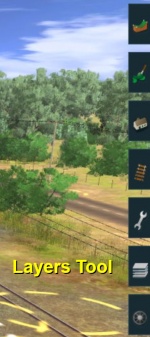 |
 |
Left Click the Layers Tool (or press F6 ) to open up its properties.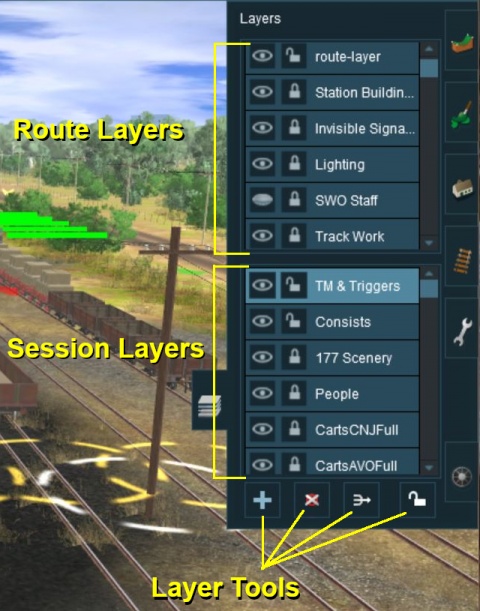 |
|
Loading a Route and Loading a Session (S10) |
| Route Layers are saved with the Route. Session Layers are saved with the Session | |
| If you edit a Session Layer and later load just the Route then those edits will not appear. |
 |
More information on creating, loading and saving Routes and Sessions can be found on the Trainz Wiki Page at Route and Session Basics |
The layers you see will depend on whether you have loaded a Route by itself (with no "child" Session) or a Session and its "parent" Route.
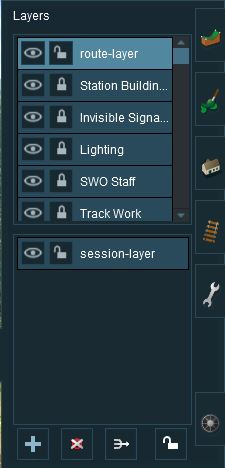 |
 |
The first image on the left gives an example of the layers that can appear if a Route only is loaded into Surveyor. These are the layers that are saved with the Route. Note that a default "session-layer" is present.
The second image on the left gives an example of the layers that can appear if a Session based on that Route is loaded into Surveyor. It shows Route Layers and Session Layers. In both cases, the Route Layers are identical because the same Route has been loaded. A Session contains its own layers, the Session Layers, that are loaded and saved with the Session but are not loaded or saved with the Route.
|
|
Creating a New Route (S10) |
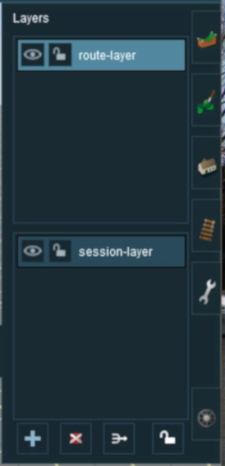 |
|
|||||||||||
The "Active Layer" (S10) |
| The Active Layer is the selected (highlighted) layer | |
| When you load the Route only into Surveyor, the first Route layer will be the Active Layer | |
| When you load a Session into Surveyor, the first Session layer will be the Active Layer |
| In the image above, the route-layer is the Active Layer. You can change the Active Layer at any time by a Left Click on the name of another layer. |
|
|
||||||||||||
Adding a New Layer (S10) |
| Left Click the Add Button |
An Add layer dialogue window will appear.
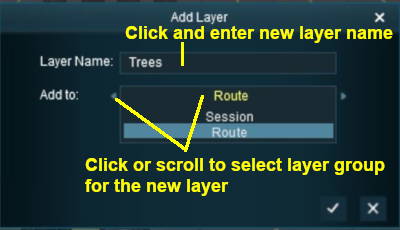 |
|
||||||||||||
Deleting a Layer (S10) |
|
| Select the layer to be deleted and Left Click on the Delete Button. If you don't select a layer to delete then Trainz will select the current Active Layer. |
|
If the layer being deleted is empty, then the following dialogue window will appear:-
 |
|
|||||||
If the layer being deleted is NOT empty, then the following dialogue window will appear:-
 |
|
|||||||||
Merging Layers (S10) |
| Merging a layer into another layer will move ALL the objects from the first layer into the second layer. The first layer, which is now empty, will then be deleted | |
| Once layers have been merged they cannot be separated. |
|
| Select the layer to be merged into another layer and Left Click the Merge button. If you don't select a layer to merge then Trainz will select the current Active Layer. |
|
The layer merge dialogue window will appear as shown below:-
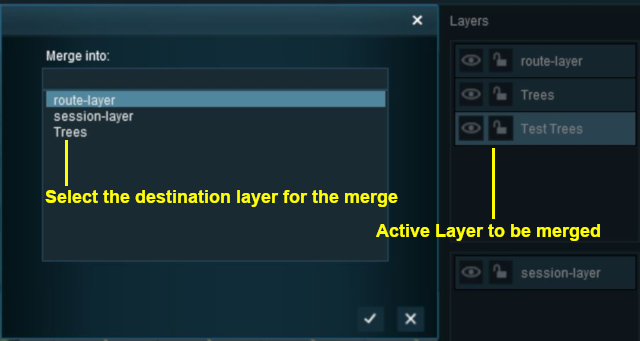 |
|
|||||||||
Locking Layers (S10) |
| If you LOCK or UNLOCK a Route Layer while editing a Session then you will have made a change to the Route and will be asked to save both the Route and the Session when you exit Surveyor |
|
Locking Individual Layers (S10)
| The objects in a LOCKED layer cannot be moved (around the layout) or deleted but they can be moved to other layers. |
To LOCK an individual layer, Left Click on the ![]() Open Padlock icon next to its name. The layer being locked does not have to be the current Active Layer.
Open Padlock icon next to its name. The layer being locked does not have to be the current Active Layer.
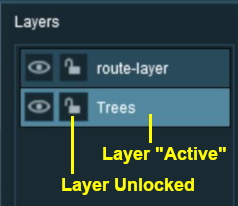 |
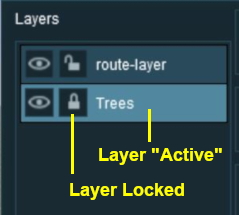 |
|
If you attempt to add a scenery object to a locked layer you will receive the following message:-
 |
Left Click on the Left Click on the |
Locking ALL Route Layers (S10)
| Left Click on the Lock Button |
This will LOCK ALL the layers in the Route Layers Group. The Session Layers Group will not be affected.
The Route Layers Group can be UNLOCKED by a Left Click on the Lock Button again.
Moving a Layer (S10) |
| Layers can be moved up or down within the same layer group (e.g. Route or Session) or between the two groups | |
| Track Objects (signals, switches, etc) should be in the same layer as the Track or in a layer below the Track layer |
|
In the example shown below a layer created in the Route Layers Group is being moved into the Session Layers Group.
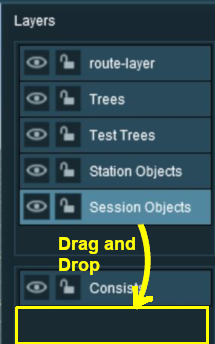 |
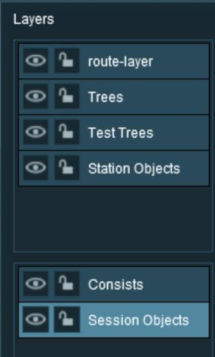 |
|
|||||||||||||||||||||
Hiding Layers (S10) |
To hide or show a layer Left Click the Eye Icon next to its name.
 |
In the image shown left the two trees are in different Route Layers and all the layers have their |
|||||||
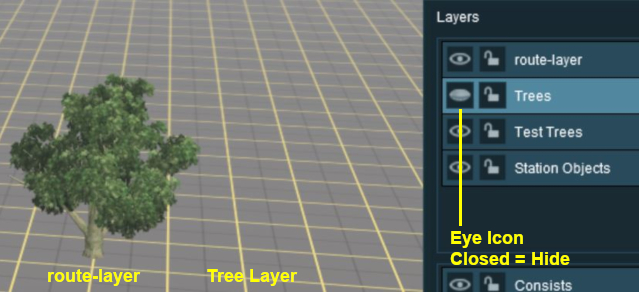 |
In the image shown left the Trees layer has its
|
Adding Objects To Layers (S10) |
| When an object (such as a scenery item, consist, track or track object) is added to the layout it is automatically placed in the currently Active Layer. Unfortunately, Surveyor Classic (S10) does not indicate which layer is the Active Layer unless you open the Layers Tool to look. This can lead to objects being placed into the wrong layers and while these objects can later be moved to another layer (see the section |
|
| You cannot add objects to a layer that is LOCKED |
If you attempt to add a scenery object to a locked layer you will receive the following message:-
 |
Left Click on the Left Click on the |
| When adding track objects (signals, speed signs, etc) to a track, the objects being added must be in the same layer as the track or in a layer below the track layer. For more information, see the section |
|
Deleting Objects From Layers (S10) |
| You cannot delete objects from a layer that is LOCKED |
|
Unfortunately Trainz does not give you a warning message when you attempt to delete an object from a locked layer, the object just refuses to be deleted.
|
Moving Objects To Other Layers (S10) |
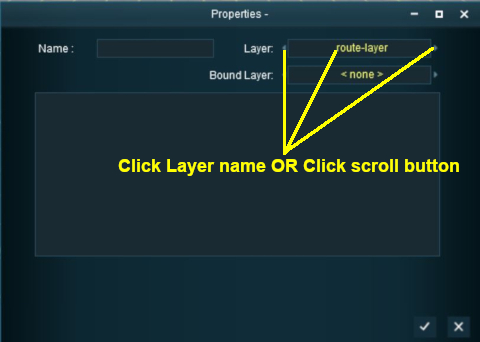
|
|
|||||||||||||||||||||
The Layers Palette in Surveyor 2.0 (S20)
|
Layers are found in the Layers Palette.
|
|
|||||||||||||||||||||||||||||||||||||||||||||||
Lock the Route Layer Group (S20)
All the layers in the Route Layer Group can be locked against accidental alteration.
|
||||||
Open a Layer Group (S20)
To the left of each Layer Group name is a small arrow. Left Click on the arrow to open up the group.
 |
The image on the left shows that the Session Layers Group is open and its individual layers are now displayed. To close or minimise the group Left Click on the arrow again.
|
||||||||
Add a New Layer (S20)
|
You cannot create new layer groups but you can add new layers to a existing group. |
Renaming a Layer (S20)
 |
Right Click on a layer name and select Rename Layer.. from the popup menu. You will be asked to enter a new name for the layer. |
Deleting a Layer (S20)
 |
Right Click on a layer name and select Delete Layer from the popup menu. You will be given a warning that you are about to delete a layer.
|
Moving a Layer (S20)
Layers can be individually moved up and down within the same layer group or between the Route Layers Group and the Session Layers Group.
|
| Left Click on a layer name and, while holding the left button down, drag the layer up or down to its new position. | |
| depending on the contents of the layer, the process may take some time. You will be shown a progress bar during the move operation | |
| the move can be reversed (after it has completed) by using the Ctrl Z keys | |
Merging a Layer (S20)
 |
Right Click on a layer name and select Merge Layer Up from the popup menu.
|
Hiding Layers (S20)
|
Each individual layer has an Eye icon that controls the visible state of that layer. Left Click on the icon to toggle its state between visible and hidden. If the Eye is:-
|
Locking Layers (S20)
|
Each individual layer has a Padlock icon that controls the state (
|
|
Setting the Active Layer (S20)
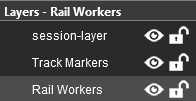 |
the Active Layer is the layer where new objects will be automatically added when using the Placement Tool. The active layer is shown in the palette with its name on a blue background. In the image on the left the Rail Workers layer is the current Active Layer. The name of the current Active Layer is also shown in the Layer Palette Title Bar. To set a new Active Layer, Double Left Click on a layer name. |
Move an Object to a New Layer (S20)
| The Info Palette will show the layer assigned to the currently selected object. An object is selected by using the Free Move Tool (the S key) or the Fine Adjustment Tool (the D key) found in the Tools Palette.
|
||||||||||
|
|
|
|||||||||
Route Layers vs Session Layers
This topic has filled endless threads in the Trainz Forums with arguments raging on both sides.
| In general, there are no "cast iron" rules that dictate what should be placed in the Route Layers Group and what should be placed in the Session Layers Group (for an exception see TRS19 Platinum Edition, Trainz Plus, TRS22 Notes below) |
| Each Route and Session will be different and different creators have different ways of working. The main question to be asked is how many different Sessions will be created using a particular Route? |
Notes:
|
TRS19 Platinum Edition, Trainz Plus, TRS22 Notes:
|
|||||||||
The Route Layers Group |
| The Route Layer Group should be used for everything that will always appear in Driver Mode regardless of which Session is playing. |
There is nothing stopping you from placing everything in the "route-layer" of the Route Layers Group and never having to worry about dealing with layers ever again - some creators prefer to work this way. However, layers do provide you with a way of organising your scenery objects to make them more manageable, particularly in more complicated layouts. Some examples:-
|
|
The "route-layer"
| To avoid any confusion over which layer is the original "route-layer", this is one layer that should not be renamed or moved from the top position |
While all layers are equal, the "route-layer" is special.
|
|
||||||||||||
The Session Layers Group |
| The Session Layers Group should be used for everything that will only be seen in the currently loaded Session. |
If you are creating more than one Session based around a particular Route, then you will probably make use of the Session Layers.
|
|
The "session-layer"
|
|
|||||||||
The Bound Layer
| In Trainz Plus and TRS22 the Bound Layer is often referred to as the Binding Layer |
This is a little used and probably little understood layer feature. It allows you to attach an object to two different layers so it can have the properties (locked/unlocked and show/hide) of both layers. The bound/binding layer was introduced as a development tool, its sole use is as a tool in the building of routes and sessions.
| An object will be LOCKED and cannot be deleted or moved if its layer OR its bound/binding layer is locked. | |
| An object will be HIDDEN if its layer OR its bound/binding layer is hidden. | |
| Rulers cannot be bound to another layer. |
|
|
||||||||||||||||||||||||||||||||||||||||
|
|
||||||||||
|
Setting an Object to the Bound Layer in Surveyor Classic (S10) |
 |
|
||||||||||
| When a layer is deleted any objects bound to that layer will have their Bound Layer reset to <none> |
Setting an Object to the Bound Layer in Surveyor 2.0 (S20) |
|
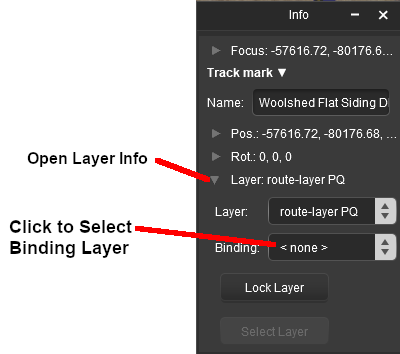 |
|
|||||||||||||
| When a layer is deleted any objects bound to that layer will have their Bound Layer reset to <none> |
Layers in Driver Mode
During the running of a Session in Driver Mode visible layers can be hidden and invisible layers revealled according to the events that occur during the Session.
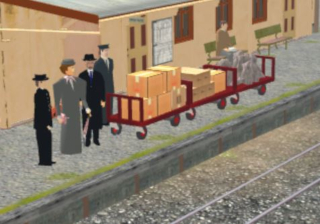 |
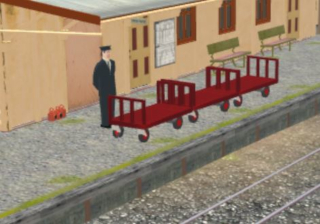 |
The two Driver Mode scenes shown on the left illustrate this feature.
|
|||||||
| This effect could be achieved in two different ways:- | |
| A Driver Command - specific to a particular driver, or | |
| A Session Rule - specific to a particular driver, consist, or any driver/consist | |
Using a Driver Command
The driver command Layer Control hides and shows named layers.
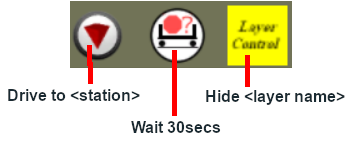
Using Session Rules
 |
Rules Used: |
- Trackside Check Rule - to trigger the event
- Show/Hide Layer Rule - to hide layers
- Message Popup Rule - to open a browser window with a message
 |
Session Editor Screenshot: |
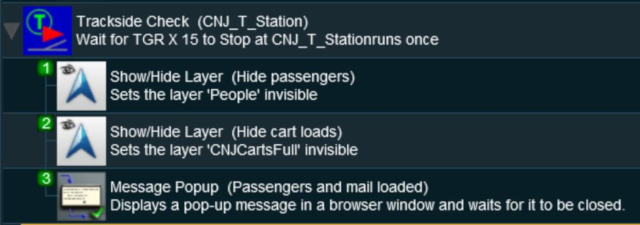 |
 |
Description: |
| In this example:- | ||||||
The Trackside Check Rule is triggered when a specific train comes to a stop at a trackmark. This then executes the following rules in order:-
|
||||||
Trainz Wiki
 |
More Tutorials and Guides to Using Trainz |
This page was created by Trainz user pware in June 2018 and was last updated as shown below.
